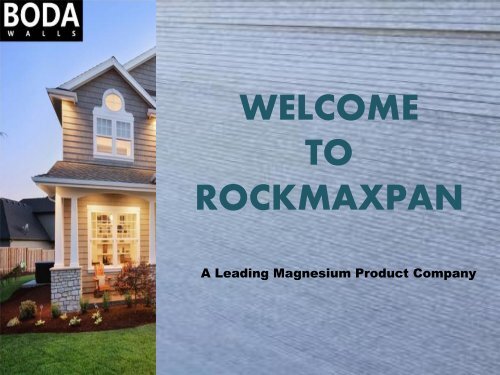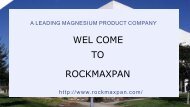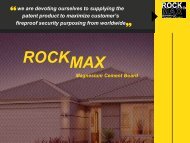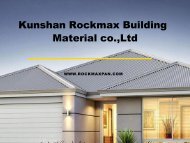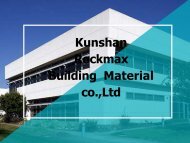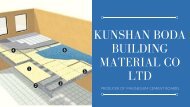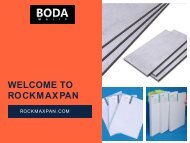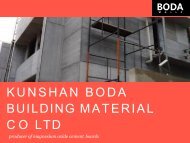You also want an ePaper? Increase the reach of your titles
YUMPU automatically turns print PDFs into web optimized ePapers that Google loves.
WELCOME<br />
TO<br />
ROCKMAXPAN<br />
A Leading <strong>Magnesium</strong> Product Company
About Rockmaxpan<br />
Kunshan Boda Building Material Co.,LTd.is a new company established in 2010, which<br />
is original designer and professional producer of magnesium oxide cement boards, our<br />
production base covers 10000 m2,located in SuZhou City, Jiangsu province, about 60<br />
km from Shanghai.<br />
We continue to research and develop on new concrete technology that has been<br />
ahead of industry. Our group company has been member of CFPA(China Fire<br />
Protection Industry AsNow sociation) since 2003,most of our product has been<br />
famous in local market. we are devoting ourselves to supplying the first class product<br />
to maximize customer’s fireproof security purposing from worldwide.
MAGNESIUM-OXIDE BOARDS CAUSE MOISTURE DAMAGE INSIDE<br />
FACADES IN NEW DANISH BUILDINGS<br />
<strong>Magnesium</strong> oxide board, “MgO-board”, is a factory-made sheathing board product,<br />
which has been widely used in the last 5 years in ventilated facades on new or<br />
renovated buildings in Denmark. In winter 2014/15, a number of problems began to<br />
appear with these boards since the boards and adjoining building elements seemed to<br />
suffer from some sort of disease, which manifested itself by damages such as significant<br />
moisture, boards leaking salty water (‘tears’),corrosion of fittings and anchors and<br />
mould growth.
Introduction<br />
In winter 2014/15, many moisture damages were observed inside ventilated facades of<br />
new or newly renovated Danish buildings. The moisture damaged facades were<br />
constructed with sheathing made of magnesium oxide-boards (MgO-boards) facing the<br />
air gap behind the material used for exterior siding. MgO-boards have often been used<br />
as sheathing behind a ventilated air gap as shown in Figure 1 and Figure 3. A photo of<br />
a MgO-board is shown in Figure.<br />
International RILEM Conference on Materials, Systems and Structures in Civil<br />
Engineering Conference segment on Moisture in Materials and Structures 22-24<br />
August 2016, Technical University of Denmark, Lyngby, Denmark
Figure 1: Sketch of a typical façade construction where a sheathing board is used as<br />
wind barrier. Adapted from [1]. Figure 2: Photo of 8 mm thick MgO-board with a glass<br />
fibre mesh on both surfaces. The observed damages were caused by the fact that MgOboards<br />
absorb moisture from outside air.<br />
Water drops containing chloride ions appear on the outside of the boards – often so<br />
many that they run down the vertical boards and out via the air gap behind the siding<br />
boards (see Figures 4 and 5). The metal mountings for the MgO-boards can corrode<br />
heavily within a few years, cf. Figure 6.
Figure 5: The water drops containing<br />
chloride ions run down the vertical MgOboards<br />
and drain out of the wall from<br />
behind the wall’s siding boards.<br />
Figure 6: The zink covering of the steel<br />
profile is corroded as a result of direct<br />
contact with salty sweat or ‘tear’ drops<br />
from the adjacent MgO-board.
The binder in MgO-boards is formed by a chemical reaction between MgO and MgCl2,<br />
which is known as magnesium oxychloride cement, or Sorel cement, and which is a nonhydraulic<br />
cement first produced by Stanislas Sorel in 1867 [2] mainly to be used as a<br />
flooring material The cement is a mixture of magnesium oxide and magnesium chloride<br />
– typically with a weight ratio of 2.5-3.5 parts MgO to one part MgCl2. The magnesium<br />
oxychloride cement is formed by mixing a magnesium chloride (MgCl2) brine solution<br />
with a magnesium oxide(MgO) composition in a selected stoichiometric ratio of MgCl2,<br />
MgO, and H2O. Various explanations about the product and its possible use and<br />
qualities can be found in literature.
in a petri glass dish, which was placed inside a basket made of Teflon.<br />
Weighing of the basket were performed without opening the front doors of<br />
the climate chambers, as the baskets were hung up one by one below the<br />
balance by means of a steel string. Figure 9 shows the climate chamber<br />
where the actual RH is created by mixing flow of dry air with flow of<br />
saturated air.<br />
Based on a calibrated RH-sensor the connected PIDsystem<br />
regulates the dry airflow and the saturated air<br />
flow for obtaining the wanted RH. In this way, the RH is<br />
created in wanted steps.
CONTACT DETAILS<br />
Kunshan Boda Building<br />
Material Co Ltd<br />
No.18,Yuewang Industry<br />
Zone<br />
City : Suzhou<br />
Province : Jiangsu<br />
China<br />
Tel: +86-512-36904020<br />
Fax: +86-512-50130104
Also Visit us at<br />
http://www.rockmaxpan.com/<br />
https://www.facebook.com/rockmaxpanel<br />
https://twitter.com/rockmaxmgoboard<br />
Thank You


